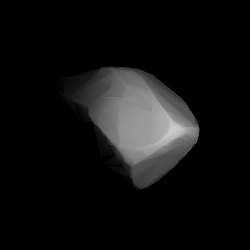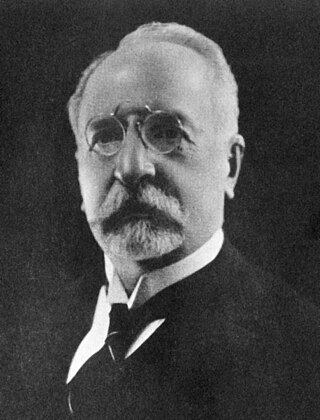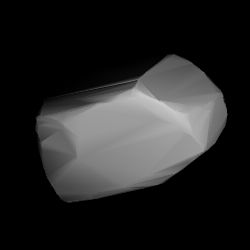Related Research Articles
Brett James Gladman is a Canadian astronomer and a full professor at the University of British Columbia's Department of Physics and Astronomy in Vancouver, British Columbia. He holds the Canada Research Chair in planetary astronomy. He does both theoretical work and observational optical astronomy.

Johann Palisa was an Austrian astronomer, born in Troppau, Austrian Silesia, now Czech Republic. He was a prolific discoverer of asteroids, discovering 122 in all, from 136 Austria in 1874 to 1073 Gellivara in 1923. Some of his notable discoveries include 153 Hilda, 216 Kleopatra, 243 Ida, 253 Mathilde, 324 Bamberga, and the near-Earth asteroid 719 Albert. Palisa made his discoveries without the aid of photography, and he remains the most successful visual (non-photographic) asteroid discoverer of all time. He was awarded the Valz Prize from the French Academy of Sciences in 1906. The asteroid 914 Palisana, discovered by Max Wolf in 1919, and the lunar crater Palisa were named in his honour.
Lyudmila Georgievna Karachkina is an astronomer and discoverer of minor planets.

124 Alkeste is a main-belt asteroid, and it is an S-type (silicaceous) in composition. C.H.F. Peters discovered the asteroid on August 23, 1872, from the observatory at Hamilton College, New York State. The name was chosen by Adelinde Weiss, wife of the astronomer Edmund Weiss, and refers to Alcestis, a woman in Greek mythology.
Lutz Dieter Schmadel was a German astronomer and a prolific discoverer of asteroids, who worked at the Astronomisches Rechen-Institut (ARI) of the University of Heidelberg.
Petr Pravec is a Czech astronomer and a discoverer of minor planets, born in Třinec, Czech Republic.
Timothy Bruce Spahr is an American astronomer and prolific discoverer of minor planets.
Pierre Antonini is a retired French mathematics professor and amateur astronomer who has discovered several minor planets and two supernovae at his private Observatoire de Bédoin located at Bédoin, southeastern France. For many of his discoveries he used a 16-cm telescope or a 30-cm telescope.

317 Roxane is an asteroid from the asteroid belt approximately 19 km in diameter. It was discovered by Auguste Charlois from Nice on September 11, 1891. The name was chosen by F. Bidschof, an assistant at the Vienna Observatory, at Charlois' request; Bidschof chose to name it after Roxana, the wife of Alexander the Great, and at first used the spelling "Roxana".
356 Liguria is a very large main-belt asteroid that was discovered by Auguste Charlois on January 21, 1893, in Nice. It is one of seven of Charlois's discoveries that was expressly named by the Astromomisches Rechen-Institut, and was named for the Italian region.

2002 Euler is a stony background asteroid from the inner regions of the asteroid belt, approximately 17 kilometers (11 miles) in diameter. It was discovered on 29 August 1973, by Russian astronomer Tamara Smirnova at the Crimean Astrophysical Observatory in Nauchnyj, and assigned the prov. designation 1973 QQ1. It was named after Swiss mathematician Leonhard Euler.

495 Eulalia is a minor planet, specifically an asteroid orbiting in the asteroid belt. Eulalia is very near the 3:1 Jupiter orbital resonance.
965 Angelica, is a large background asteroid from the outer regions of the asteroid belt, approximately 60 kilometers in diameter. It was discovered on 4 November 1921, by astronomer Johannes F. Hartmann at the La Plata Astronomical Observatory in Argentina. The dark X-type asteroid (Xc) with a low TJupiter has a rotation period of 26.8 hours and is likely spherical in shape. It was named after the discoverer's wife, Angelica Hartmann.

Johannes Franz Hartmann was a German physicist and astronomer. In 1904, while studying the spectroscopy of Delta Orionis he noticed that most of the spectrum had a shift, except the calcium lines, which he interpreted as indicating the presence of interstellar medium.
1988 Delores, provisional designation 1952 SV, is a stony Florian asteroid from the inner regions of the asteroid belt, approximately 5 kilometers in diameter.

1961 Dufour is a large background asteroid, approximately 50 kilometers in diameter, located in the outer region of the asteroid belt. It was discovered on 19 November 1973, by Swiss astronomer Paul Wild at Zimmerwald Observatory near Bern, Switzerland, and later named for 19th-century Swiss General Henri Dufour.
2143 Jimarnold, provisional designation 1973 SA, is a background asteroid from the inner regions of the asteroid belt, approximately 5 kilometers in diameter. It was discovered on 26 September 1973, by astronomer Eleanor Helin at the Palomar Observatory in California, United States. The asteroid was named after American cosmochemist, James R. Arnold.
2623 Zech, provisional designation A919 SA, is a stony binary asteroid from the inner regions of the asteroid belt, approximately 6.5 kilometers in diameter. It was discovered on 22 September 1919, by German astronomer Karl Reinmuth at Heidelberg Observatory in southwest Germany. It was named after German ARI astronomer Gert Zech.
2661 Bydžovský, provisional designation 1982 FC1, is an asteroid from the outer region of the asteroid belt, approximately 30 kilometers in diameter. It was discovered on 23 March 1982, by Czech astronomer Zdeňka Vávrová at the South Bohemian Kleť Observatory in the Czech Republic. The asteroid was named after mathematician Bohumil Bydžovský.
Paul Herget was an American astronomer and director of the Cincinnati Observatory, who established the Minor Planet Center after World War II.
References
- 1 2 "Dr. Donald R. Davis". Psi.edu. Retrieved 4 November 2014.
- ↑ "The Origin of the Moon". Psi.edu. 2010-09-07. Retrieved 4 November 2014.
- ↑ "JPL Small-Body Database Browser: 49673 (1999 RA215)" (2013-10-06 last obs.). Jet Propulsion Laboratory . Retrieved 20 June 2016.
- ↑ "49673 (1999 RA215)". Minor Planet Center. Retrieved 20 June 2016.
- ↑ Haims, Eli (1 September 2010). "Summer Science Program". The Chronicle. Los Angeles: Harvard-Westlake School. Retrieved 26 July 2016.
- ↑ Schmadel, Lutz D. (2007). "(3638) Davis". Dictionary of Minor Planet Names – (3638) Davis. Springer Berlin Heidelberg. p. 306. doi:10.1007/978-3-540-29925-7_3636. ISBN 978-3-540-00238-3.
- Hartmann, W. K., & Davis, D. R. (1975). Satellite-sized planetesimals and lunar origin. Icarus, 24(4), 504-515.
- Minor Planet Center: Discovery Circumstances: Numbered Minor Planets (45001)-(50000)
- Jewitt, D., & Luu, J. (2000). Physical nature of the Kuiper Belt. In Protostars and Planets IV (Vol. 1, pp. 1201-1229). University of Arizona Press.
- Schmadel, Lutz D. (2003). Dictionary of Minor Planet Names. Springer Science & Business Media.
- Summer Science Program: Alumni Tribute to Brendan Kutler